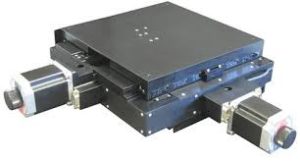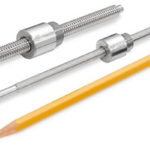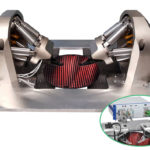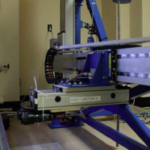XY tables are constructed from two linear axes – typically driven by linear motors, ball screws, or lead screws – that are mounted perpendicular to each other in either a stacked or a monolithic design.
Stacked XY tables consist of two complete, separate axes mounted together, much the same way they are configured in a basic XY Cartesian system. With a stacked design, there are few restrictions on the type and configuration of each axis. For example, the bottom (X) axis could be linear motor driven while the top (Y) axis is ball screw driven. This flexibility, along with simple manufacturing and assembly, make stacked tables a popular design.
Monolithic XY tables consist of two axes that have been integrated together. Instead of two independent axes mounted to each other, this design integrates the top (moving part) of the X axis and the bottom (stationary part) of the Y axis into one single structure that serves both axes. This connecting structure is referred to as a monolithic center.

Image credit: Dover Motion
Monolithic tables are also referred to as integral tables, compound architecture tables, and three-piece tables.
The most noticeable benefit of monolithic XY tables is a more compact design. By taking an assembly that is typically made of four parts (X axis base, X axis carriage, Y axis base, and Y axis carriage) and making it with just three parts (X axis base, monolithic center, and Y axis carriage), the assembly’s overall height is reduced significantly.
But the monolithic design has other benefits as well. First, the use of a common structure connecting the two axes allows better control of orthogonality between the axes. This is critical in applications such as microscopy, inspection, and micromachining, where not only are the independent X and Y positions important, but so is the position of the axes relative to each other.
Monolithic XY tables also provide better rigidity than stacked designs, for the simple reason that fewer attachment points means fewer points where deflection can occur. Another benefit of monolithic tables is that they allow the motors for both the X and Y axes to be attached to the center section and move with the X axis. This lowers the moved mass and inertia of the Y axis, and results in less moment loading on the X axis.
The term monolithic, when applied to a single linear axis, can also refer to a construction method in which the bearing raceways are machined into the platform, or body, of the table. This design does away with the traditional rail, shaft, or guide that would be mounted to the platform, which further reduces components and mechanical connection points, resulting in even higher stiffness and rigidity of the overall system. It also eliminates the potential influences of thermal expansion on linear bearing preload.
Feature image credit: Nutec







Leave a Reply
You must be logged in to post a comment.